Krim |
|
|
|
| Übersicht – Contents: | |
Krim |
|
|
|
| Übersicht – Contents: | |
Flagge – Flag: |
|
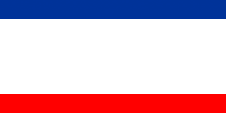 |
Nationalflagge – national flag, Seitenverhältnis – ratio = 1:2, Quelle/Source, nach/by: Flaggen Enzyklopädie |
historische Flaggen – historical Flags: |
|
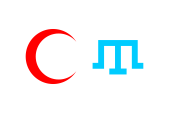 |
bis/to 1783, Flagge Krim-Khanat – flag of the Khanate of Crimea Quelle/Source, nach/by: World Statesmen |
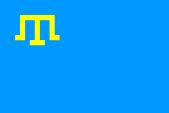 |
1917–1919, Regierung der Krim-Tataren – Government of the Crimean Tatars Quelle/Source, nach/by: World Statesmen |
 |
1918–1921, Regierung der Bolschewisten – Government of the Bolshevists Quelle/Source, nach/by: World Statesmen |
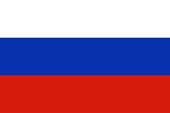 |
1919–1920, Flagge der bürgerlichen Regierung – flag of the civil government, Seitenverhältnis – ratio = 2:3, Quelle/Source, nach/by: World Statesmen   |
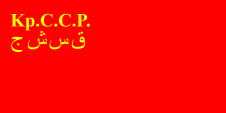 |
1921–1928, Flagge der Autonomen Sowjetrepublik – flag of the Autonomous Soviet Republic, Seitenverhältnis – ratio = 1:2, Quelle/Source, nach/by: World Statesmen |
 |
1929–1937, Flagge der Autonomen Sowjetrepublik – flag of the Autonomous Soviet Republic, Seitenverhältnis – ratio = 1:2, Quelle/Source, nach/by: World Statesmen |
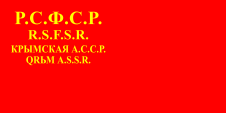 |
1937–1938, Flagge der Autonomen Sowjetrepublik – flag of the Autonomous Soviet Republic, Seitenverhältnis – ratio = 1:2, Quelle/Source, nach/by: World Statesmen |
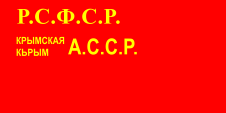 |
1938–1942, 1944–1945, Flagge der Autonomen Sowjetrepublik – flag of the Autonomous Soviet Republic, Seitenverhältnis – ratio = 1:2, Quelle/Source, nach/by: World Statesmen |
|
siehe auch – look also: Flaggengeschichte der Sowjetrepubliken der UdSSR – flag history of the soviet republics of the USSR |
|
|
|
|
Krimtataren – Crimean Tatars: |
|
 |
Flagge der Krimtataren – flag of the Crimean Tatars Quelle/Source: Wikipedia (EN) |
Bedeutung/Ursprung der Flagge – Meaning/Origin of the Flag: |
|
| In der am 24.09.1992 angenommenen blau-weiß-roten Flagge der Krim erkennt man die Farben Russlands wieder, zu welchem die Halbinsel Krim bis 1954 politisch gehörte und seit 2014 wieder gehört. | In the on 24th of September of 1992 adopted blue-white-red flag of Crimea are to see the clours of Russia, to which the Crimean Peninsula belonged to the year 1954 and belongs again since 2014. |
| Die Flaggen, die zu Sowjet-Zeiten verwendet wurden, entsprachen alle dem immer gleichen Schema, wie es für Sowjetische Autonome Republiken vorgesehen war: Zwischen 1923 und 1937 oft nur ein einfabiges rotes Flaggentuch mit einer goldenen Inschrift, die den Landesnamen zeigte. Manchmal nur als Abkürzung, manchmal mit vollem Namen, manchmal nur in Russisch oder auch mehrsprachig. Ab etwa 1937 wurden manchmal noch Hammer, Sichel und Stern ergänzt. |
The flags, which were used in the Soviet era corresponded all to the same pattern as it was intended for the Soviet Autonomous Republics:
Between 1923 and 1937 frequently only a single-coloured red bunting with a golden inscription, showing the name of the country. Sometimes only as a shortcut, sometimes the full name, sometimes only in Russian or even multilingual. From about 1937 hammer, sickle and star were sometimes added. |
| Der Status der Krim als Autonome Republik wurde 1945 als Folge umfangreichen Kollaboration der nicht-russischen Bevölkerung mit dem Deutschen Reich während des Zweiten Weltkriegs aberkannt. Die bis dato gültige Flagge wurde abgeschafft. | The status of Crimea as Autonomous Republic was revoked in 1945 as a result of extensive collaboration of the non-Russian population with the German Empire during the Second World War. The until that valid flag has been abolished. |
| Die Flagge der Krim-Tatarsen zeigt ein hellblaues Flaggentuch. Im Obereck ein Zeichen, das der Symbolik der Goldenen Horde entspringt, eines riesigen Tatarenreiches, aus welchem auch die Krimtataren hervorgingen. Blau ist die Nationalfarbe der Türken und Mongolen bzw. auch der Tataren. Die im Zweiten Weltkrieg auf der Seite der Deutschen Wehrmacht kämpfenden krimtatarischen Truppen verwendeten eine ähnliche Flagge, jedoch war das Symbol im Obereck rot. | The flag of the Crimean Tatars shows a pale blue bunting. In the upper staff quadrant a sign, which comes from the symbolism of the Golden Horde, a huge Tatar empire, from which the Crimean Tatars descent. Blue is the national colour of the Turks and Mongols respectively as well of the Tatars. The in the Second World War on the side of the German War Might fighting Crimean Tatarian troops uses a similar flag, but the symbol in the upper staff quadrant was red. |
| Die Bezeichnung "Tataren" trug ursprünglich nur ein kleiner mongolischer Stamm. Während des Mongolensturms im 12. und 13. Jahrhundert wurde dieser Name auf alle Mongolen übertragen. Im 14. Jahrhundert wurde er auf jene Völker weiter verwendet, die aus der Vermischung von Mongolen, Türken, Wolgafinnen und Slawen hervorgingen und sich zum Islam bekannten. | The denomination "Tatars" held initially just a small Mongolian tribe. During
the Mongol Assault in the 12th and 13th century this name was transmitted to all the
Mongols. In the 14th century it was maintained for those nations, which arised from the mixture of Mongols, Turks, Volga Fins and Slavs and admit themselves to the Islam. |
| Quelle/Source: Flaggen Enzyklopädie, Die Völker der Erde, Volker Preuß | |
Wappen – Coat of Arms: |
|
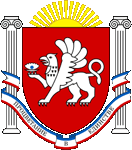 |
seit 2014, Wappen der Republik Krim – coat of arms of the Republic of Crimea, Quelle/Source: Верховна Рада Республіки Крим, Public domain, via Wikimedia Commons |
Landkarte – Map: |
|
|
Zahlen und Fakten – Numbers and Facts: |
|
|
|
|
|
|
|
|
|
|
|
|
|
|
|
Geschichte: |
|
Antike
· von Skythen bewohnt seit 600 v.Chr. · Kolonisierung durch Griechen 5.–2. Jhd. v.Chr. · zum Bosporanischen Reich 110 v.Chr. · von Griechenland erobert 63 v.Chr. · vom Römischen Reich abhängig 395 · bei der Teilung des Römischen Reiches kommt die Chersónesos (Krim) an das Oströmische Reich (Byzanz) ca. 250 · Besiedelung durch Goten ca. 375 · Besiedelung durch Hunnen ca. 650 · Besiedlung durch Chasaren, bis 890 zum Chasaren-Reich 890–990 · zum Reich der Petschenegen 988–989 · russische Eroberung unter Wladimir, Errichtung des russischen Fürstentums Tmutarakan 1061–1240 · zum Reich der Kumanen (Kumanisches Reich) 1223 · Einfall der Mongolen, die Krim wird Teil des Reiches der Goldenen Horde ca. 1260 · Byzanz verliert die letzten Besitzungen auf der Krim ca. 1420 · Zerfall des Reiches der Goldenen Horde 1438 · Entstehung des Khanats Krim als Relikt des Reiches der Goldenen Horde 1475 · das Khanat Krim muss die türkische Oberhoheit anerkennen 1783 · russische Eroberung 1853–1856 · Krimkrieg (Russland gegen Osmanisches Reich, England, Frankreich und Sardinien) 1914–1918 · Erster Weltkrieg, die Krim wird von den Mittelmächten besetzt, Abzug der Truppen nach dem Frieden von Brest-Litowsk, Ausrufung der Republik Kurultai 14.01.1918 · Machtergreifung durch die Bolschewisten 1918–1920 · Bürgerkrieg, zunächst Vertreibung der Bolschewisten durch General Denikin, erneuter Vormarsch der Bolschewisten, Verteidigung durch General Wrangel 1921 · Errichtung der Sowjetdiktatur, Bildung der Autonomen Sozialistischen Sowjetrepublik Krim innerhalb der Russischen Föderativen Sozialistischen Sowjetrepublik (Sowjetrussland) 1939–1945 · Zweiter Weltkrieg, die Krim ist von 1941 bis 1944 von deutschen Truppen besetzt, die Krim-Tataren kämpfen in einem eigenen Kampfverband auf der Seite der Deutschen Wehrmacht 1944 · Eroberung durch sowjetische Truppen, alle Krim-Tataren werden nach Zentralasien deportiert 1945 · Auflösung der Autonomen Sozialistischen Sowjetrepublik Krim und Eingliederung als Oblast (Bezirk) in die RSFSR 1954 · Anschluss der Oblast Krim an die Ukrainische Sozialistische Sowjetrepublik 1967 · die Deportation der Krim-Tataren wird durch das Parlament der Sowjetunion als Unrecht anerkannt, jedoch kein Rückkehrrecht 1988 · die Krim-Tataren dürfen offiziell auf die Krim zurückkehren 1991 · Wiedererrichtung der Autonomen Republik Krim (innerhalb der Ukraine) 1991 · Bildung des Krim-Tatarischen Parlaments "Milli Mejlis", Verkündung der nationalen Unabhängigkeit (nicht anerkannt) Januar 2014 · Putsch in Kiew, (nicht verfassungskonformer Machtwechsel), Unruhen 16.03.2014 · Volksabstimmung in der Republik Krim, eine überwältigende Mehrheit stimmt für einen Anschluss an Russland, am 18.03. beschließt das Parlament der Krim den Anschluss an Russland, am 20.03. beschließt das russische Parlament den Anschluss der Republik Krim an die Russische Föderation |
History: |
|
antiquity
· inhabited by Skythians since 600 B.C. · colonization by Greeks 5th–2nd cent. B.C. · to the Bosporan Empire 110 B.C. · conquered by Greece 63 B.C. · dependent from the Roman Empire 395 · at the partition of the Roman Empire the Chersónesos (Crimea) comes to the East Roman Empire (Byzantium) ca. 250 · settlement of the Goth ca. 375 · settlement of the Huns ca. 650 · settlement of the Chasars, to 890 to the Chasarian Empire 890–990 · to the empire of the Petsheneges 988–989 · Russian conquest under Vladimir, establishment of the Russian Principality of Tmutarakan 1061–1240 · to the Empire of the Kumanes (Kumanian Empire) 1223 · invasion of the Mongols, the Crimea becomes a part of the Empire of the Golden Horde ca. 1260 · Byzantium loses the last possessions on the Crimea ca. 1420 · disintegration of the Empire of the Golden Horde 1438 · nascence of the Khanate of Crimea as a leftover of the Empire of the Golden Horde 1475 · the Khanate of Crimea has to recognize the Turkish supremacy 1783 · Russian conquest 1853–1856 · Crimean War (Russia against the Ottoman Empire, England, France and Sardinia) 1914–1918 · First World War, the Crimea is occupied by the Central Mights, withdrawal of the troops after the Peace of Brest-Litovsk, proclamation of the Republic of Kurultai 14th of January 1918 · seizure of power by the Bolshevists 1918–1920 · civil war, initially expulsion of the Bolshevists by General Denikin, one more advance of the Bolshevists, defense by General Wrangel 1921 · erection of the Soviet dictatorship, establishment of the Autonomous Socialistic Soviet Republic of Crimea within the Russian Federative Socialistic Soviet Republic (Soviet Russia) 1939–1945 · Second World War, the Crimea is from 1941 to 1944 occupied by German troops, the Crimean Tatars fight in an own combat unit on the side of the German War Might 1944 · conquest by Soviet troops, all Crimean Tatars get deported to central Asia 1945 · dissolution of the Autonomous Socialistic Soviet Republic of Crimea and incorporation as an oblast (district) into the RSFSR 1954 · annexation of the Krim Oblast to the Ukrainian Soviet Socialist Republic 1967 · the deportation of the Crimean Tatars gets recognised by the parliament of the Soviet Union as injustice, but no right for return 1988 · for the Crimean Tatars is it officially allowed to return on the Crimea 1991 · re-establishment of the Autonomous Republic of Crimea (within Ukraine) 1991 · establishment of the Crimean Tatarian parliament "Milli Mejlis", proclamation of the national independence (not recognized) January 2014 · coup in Kiev, (not constitutionally compliant change of power), riots 16th of March in 2014 · referendum in the Republic of Crimea, an overwhelming majority votes in favor of a connection to Russia, on 18th of March the parliament of Crimea decides the affiliation to Russia, on 20th of March the parliament of Russia decides the affiliation of the Republic of Crimea to the Russian Federation |
| Quelle/Source: Atlas zur Geschichte, Die Völker der Erde, Wikipedia (DE), Avantgarde für Europa, Volker Preuß |
Ursprung des Landesnamens – Origin of the Country's Name: |
|
| Die Bezeichnung "Krim" stammt aus der Zeit der Mongolenherrschaft. Das mongolische Wort "Krym" bedeutet "Festung". Im Altertum hieß die Halbinsel "Taurische Halbinisel" oder "Skythische Halbinsel", nach der Kolonisierung durch die Griechen "Chersónesos", was einfach nur "Halbinsel" heißt. | The designation "Crimea" descends from the times of the Mongol rule. The Mongolian word "Krym" means "fortification". In the antiquity the peninsula was named "Taurian Peninsula" or "Skythian Peninsula", after the colonization by the Greek "Chersónesos", what simply means "peninsula". |
| Quelle/Source: Atlas der wahren Namen, Wikipedia (DE), Volker Preuß | |